今天,公众号将为全网读者带来QMT量化实战系列!
公众号将为大家多维度、多策略、多场景来讲述QMT量化平台的实践应用。同时,我们对每段代码都做了解读说明,愿你在Quant的道路上学有所获!
此系列将由浅入深,每月1~2期,大家敬请期待!
今日复现策略:《聚宽年化30%+的ETF轮动策略》
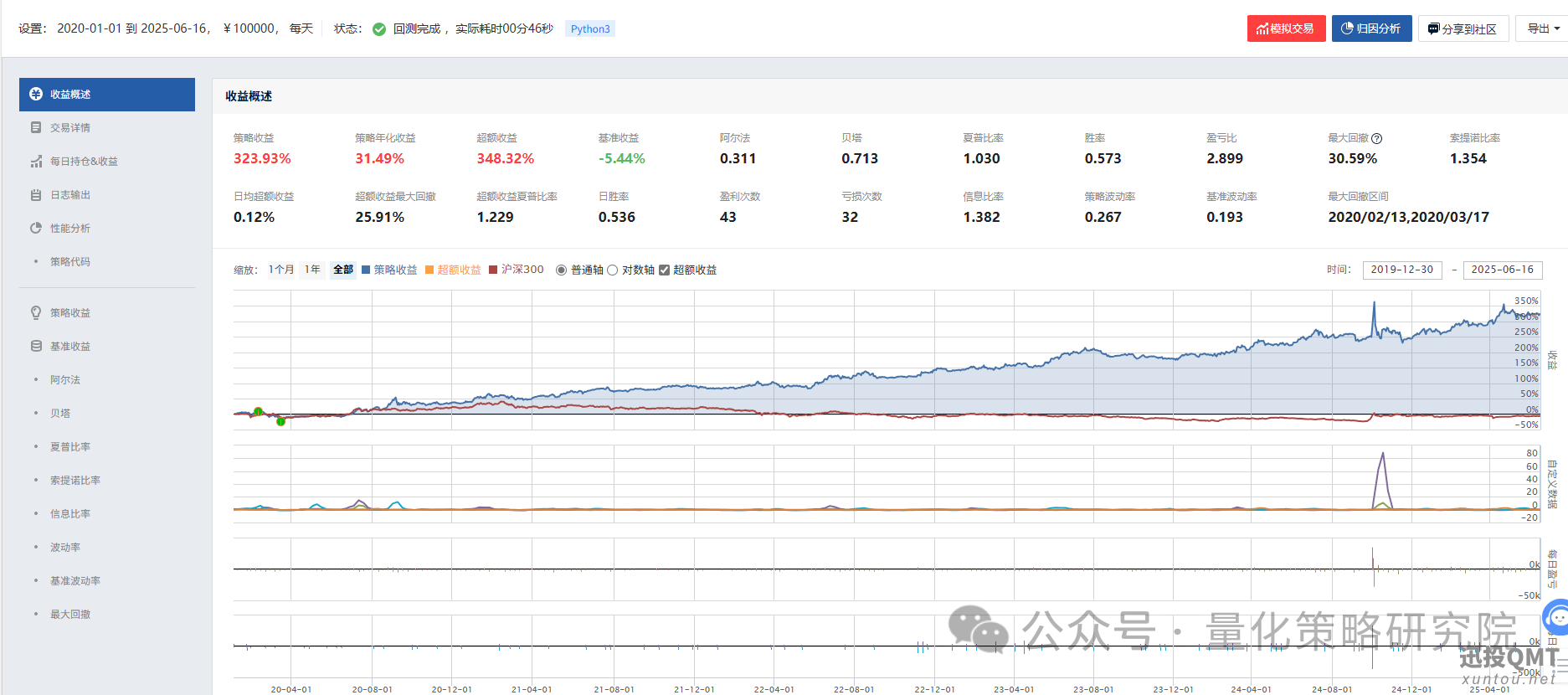
策略逻辑解读
🧠 策略核心
从4只ETF中选择动量最强的1只持有,其余清仓。
⚙️ 动量评分
- 取每只ETF近25日收盘价
- 回归计算上涨趋势(斜率)
- 年化收益 × 拟合优度 R2R^2R2 = 动量得分
- 分数越高代表走势越强
🔁 交易逻辑
卖出:不在得分最高的ETF清仓
买入:若目标ETF未持有,用可用资金买入
⏱️ 执行频率
每日调仓一次
聚宽策略定义
import numpy as np
import pandas as pd
import math # 需要导入 math 模块,因为你在代码中使用了 math.pow 和 math.exp
# 初始化函数
def initialize(context):
# 设定基准
set_benchmark('000300.XSHG')
# 用真实价格交易
set_option('use_real_price', True)
# 打开防未来函数
set_option("avoid_future_data", True)
set_slippage(FixedSlippage(0.000)) # 修正缩进
# 设置交易成本
set_order_cost(OrderCost(open_tax=0, close_tax=0, open_commission=0.0002, close_commission=0.0002, close_today_commission=0, min_commission=5), type='fund')
# 过滤一定级别的日志
log.set_level('system', 'error')
# 参数
g.etf_pool = [
'518880.XSHG', # 黄金ETF(大宗商品)
'513100.XSHG', # 纳指100(海外资产)
'159915.XSHE', # 创业板100(成长股,科技股,中小盘)
'510180.XSHG', # 上证180(价值股,蓝筹股,中大盘)
]
g.m_days = 25 # 动量参考天数
run_daily(trade, '9:30') # 每天运行确保即时捕捉动量变化
def get_rank(etf_pool):
score_list = []
for etf in etf_pool:
df = attribute_history(etf, g.m_days, '1d', ['close'])
y = df['log'] = np.log(df.close)
x = df['num'] = np.arange(df.log.size)
slope, intercept = np.polyfit(x, y, 1)
annualized_returns = math.pow(math.exp(slope), 250) - 1
r_squared = 1 - (sum((y - (slope * x + intercept))**2) / ((len(y) - 1) * np.var(y, ddof=1)))
score = annualized_returns * r_squared
score_list.append(score)
df = pd.DataFrame(index=etf_pool, data={'score': score_list})
df = df.sort_values(by='score', ascending=False)
rank_list = list(df.index)
record(黄金=round(df.loc['518880.XSHG'], 2))
record(纳指=round(df.loc['513100.XSHG'], 2))
record(成长=round(df.loc['159915.XSHE'], 2))
record(价值=round(df.loc['510180.XSHG'], 2))
return rank_list
# 交易
def trade(context):
# 获取动量最高的一只ETF
target_num = 1
target_list = get_rank(g.etf_pool)[:target_num]
# 卖出
hold_list = list(context.portfolio.positions)
for etf in hold_list:
if etf not in target_list:
order_target_value(etf, 0)
print('卖出' + str(etf))
else:
print('继续持有' + str(etf))
# 买入
hold_list = list(context.portfolio.positions)
if len(hold_list) < target_num:
value = context.portfolio.available_cash / (target_num - len(hold_list))
for etf in target_list:
if context.portfolio.positions[etf].total_amount == 0:
order_target_value(etf, value)
print('买入' + str(etf))
QMT复现过程
step 1:函数对比
| 聚宽 |
QMT |
说明 |
attribute_history |
get_market_data_ex |
获取历史数据 |
`...portfolio.positions ` |
get_trade_detail_data |
获取当前持仓 |
...olio.available_cash |
get_trade_detail_data |
获取当前资金 |
order_target_value |
order_target_value |
下单(QMT此函数非实盘) |
record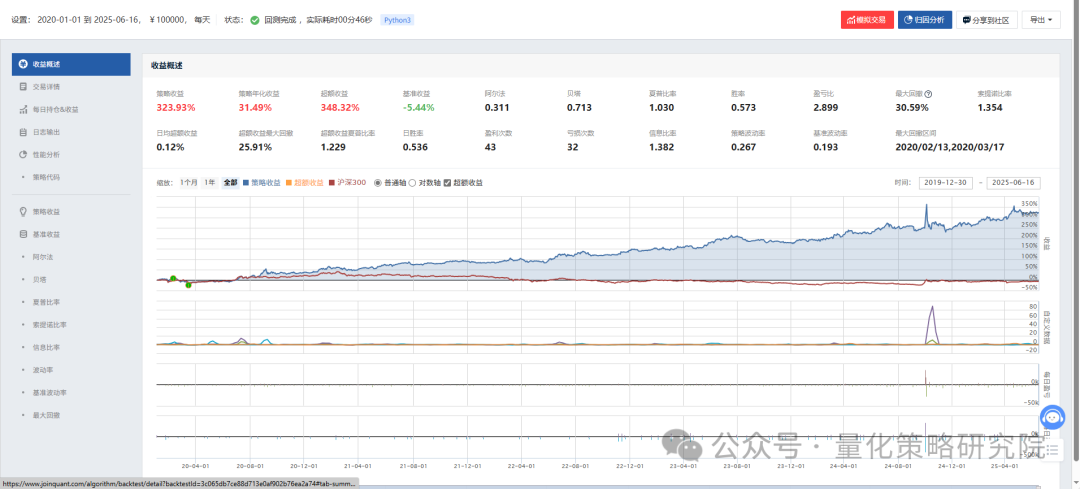 |
draw_text |
绘图函数 |
step 2:get_rank函数
def get_rank(ContextInfo):
"""
对 ETF 进行动量评分,返回得分从高到低的ETF列表
动量评分 = 年化收益 * 拟合优度(R2)
"""
bar_date = timetag_to_datetime(ContextInfo.get_bar_timetag(ContextInfo.barpos - 1), '%Y%m%d%H%M%S')
score_list = []
etf_pool = ContextInfo.etf_pool
df_list = df = ContextInfo.get_market_data_ex(['close'],etf_pool, end_time=bar_date, period='1d', count=ContextInfo.m_days, subscribe=False)
# 获取过去N日的收盘价数据
for etf in etf_pool:
df = df_list[etf]
if df is None or df.empty or df['close'].isnull().all() or len(df) < 5:
print(f'{etf}行情数据不足 跳过')
continue
# 计算对数收益回归斜率(近似日收益率)
y = df['log'] = np.log(df.close)
x = df['num'] = np.arange(df.log.size)
slope, intercept = np.polyfit(x, y, 1)
# 年化收益率 = e^(slope * 250) - 1
annualized_returns = math.pow(math.exp(slope), 250) - 1
# 拟合优度R2
r_squared = 1 - (sum((y - (slope * x + intercept)) ** 2) / ((len(y) - 1) * np.var(y, ddof=1)))
# 综合打分
score = annualized_returns * r_squared
score_list.append(score)
df_score = pd.DataFrame(index=etf_pool, data={'score': score_list})
df_score = df_score.sort_values(by='score', ascending=False)
return list(df_score.index)
复现结果验证
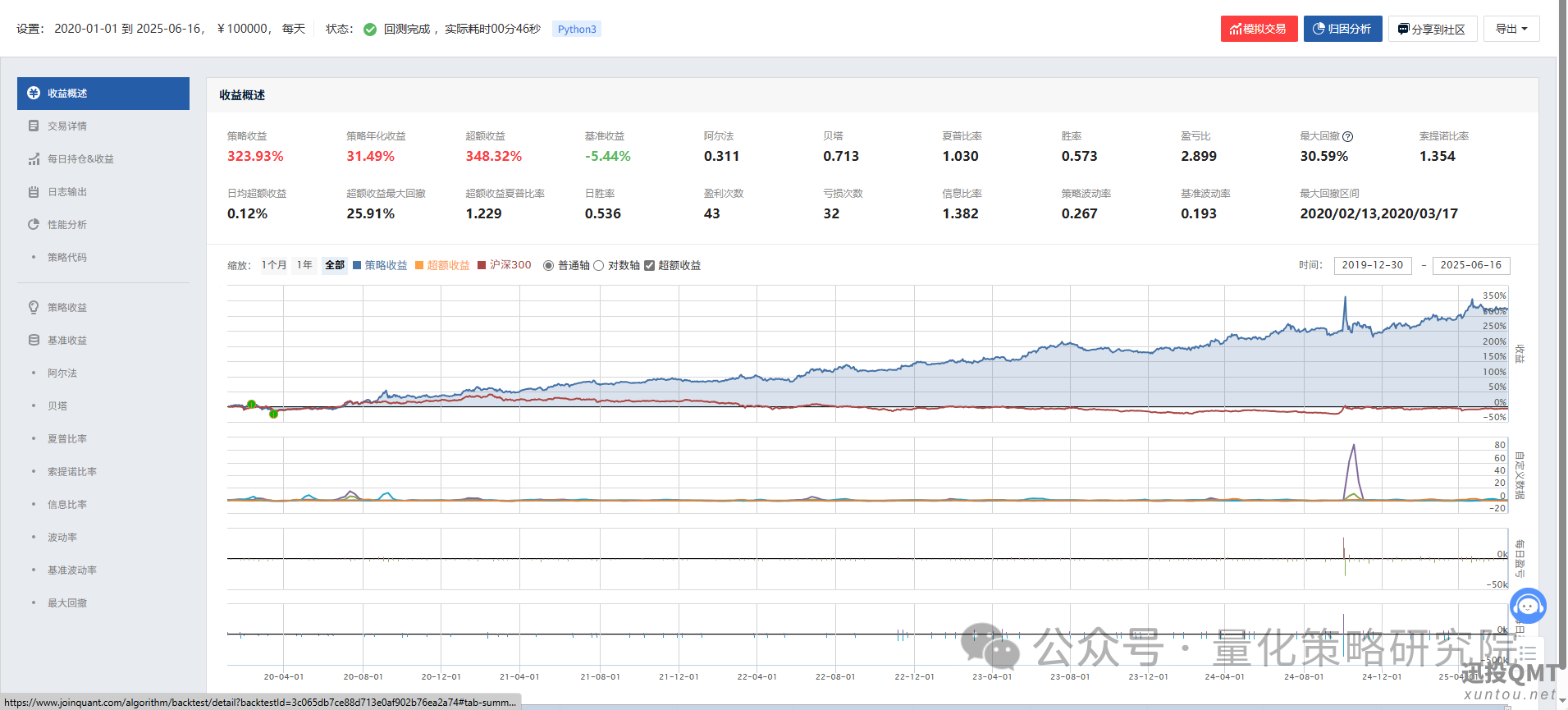
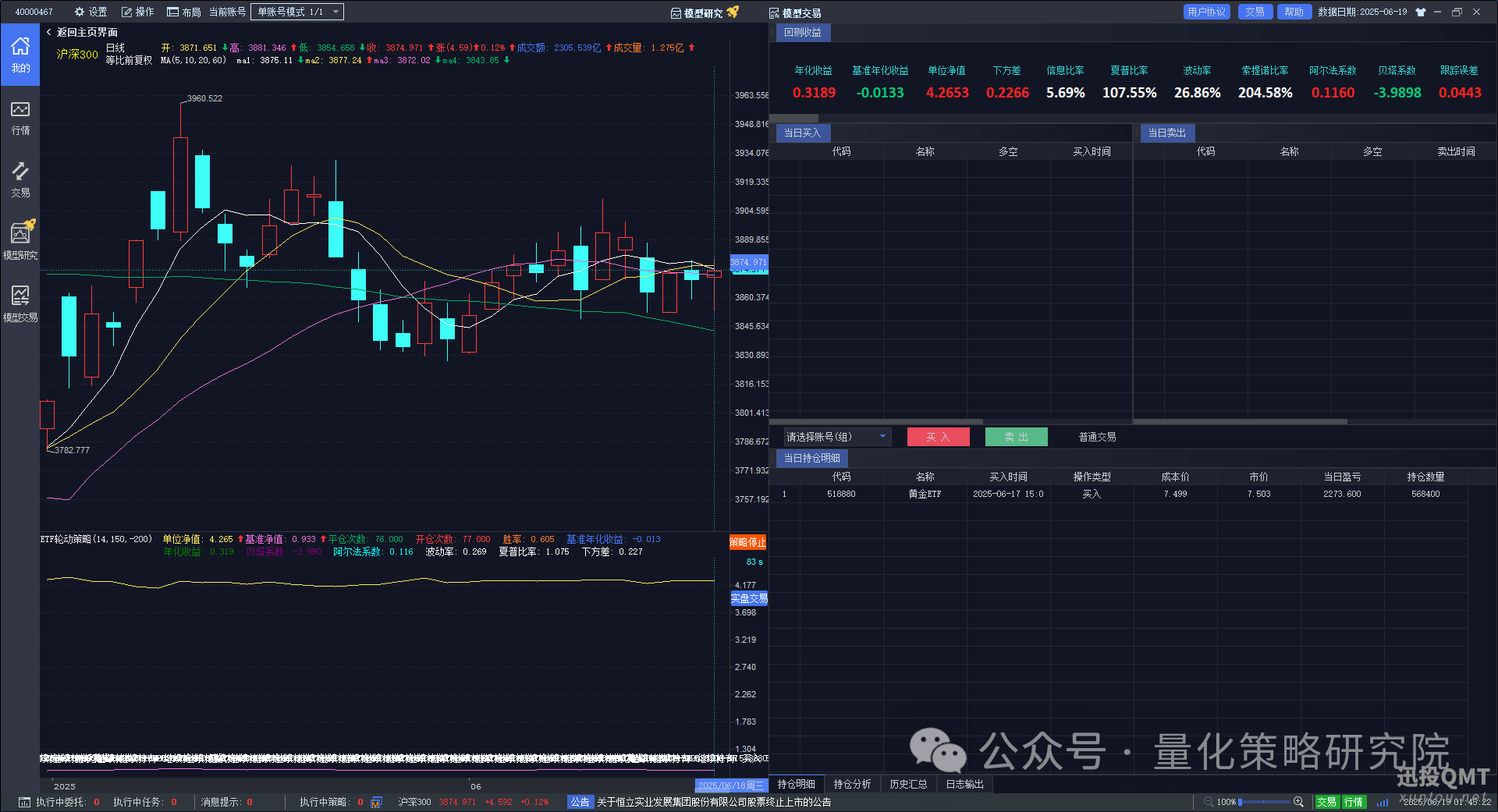
交易明细验证
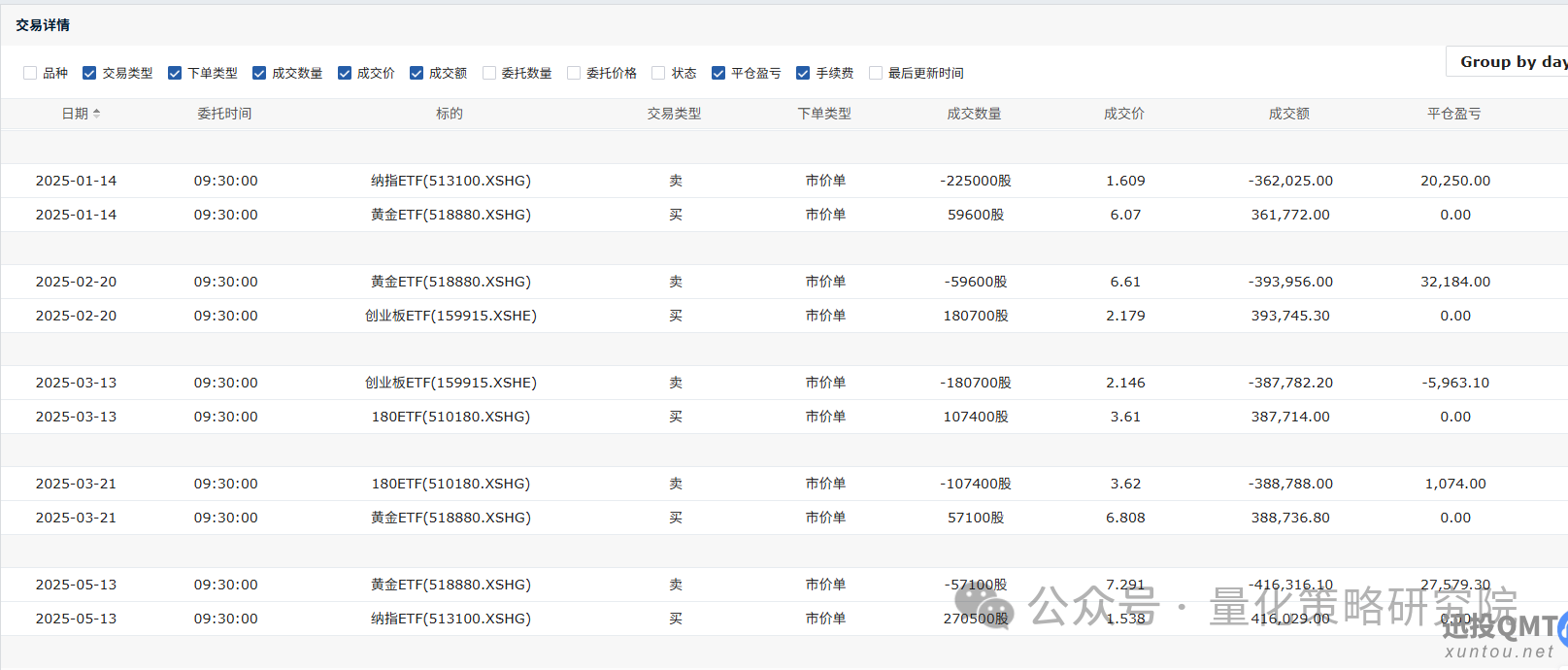
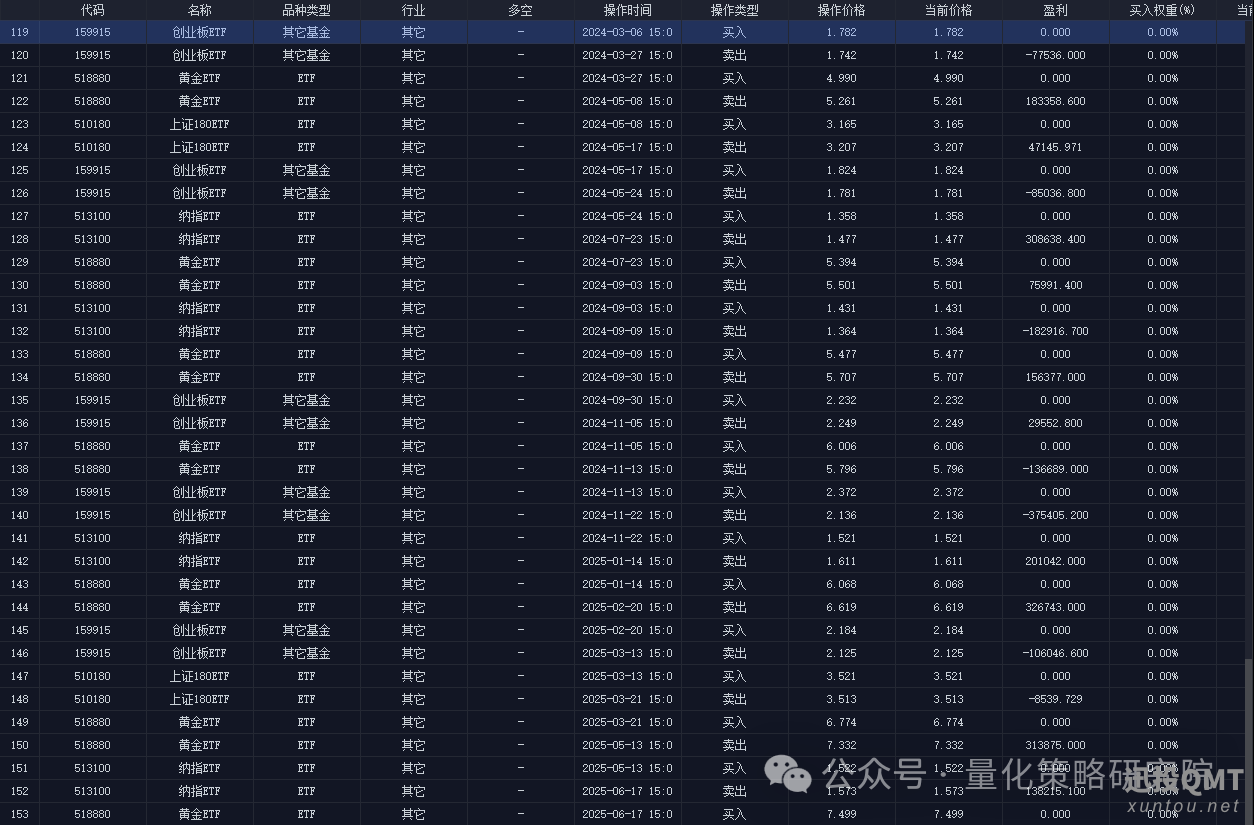
需要进量化交流群的可以加微信

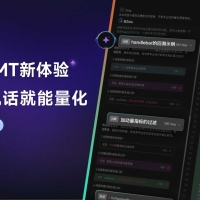 🔥迅投用户速速关注:论坛未公开的量化技巧4629 人气#QMT投研数据服务
🔥迅投用户速速关注:论坛未公开的量化技巧4629 人气#QMT投研数据服务 【圈子推荐】《免费·5分钟策略调试》适合 73825 人气#QMT投研数据服务
【圈子推荐】《免费·5分钟策略调试》适合 73825 人气#QMT投研数据服务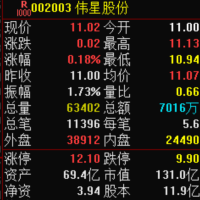 关于市值计算的问题39 人气#有问必答
关于市值计算的问题39 人气#有问必答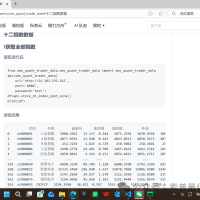 量化上线-上线强大的数据库管理系统57 人气#量化经典
量化上线-上线强大的数据库管理系统57 人气#量化经典